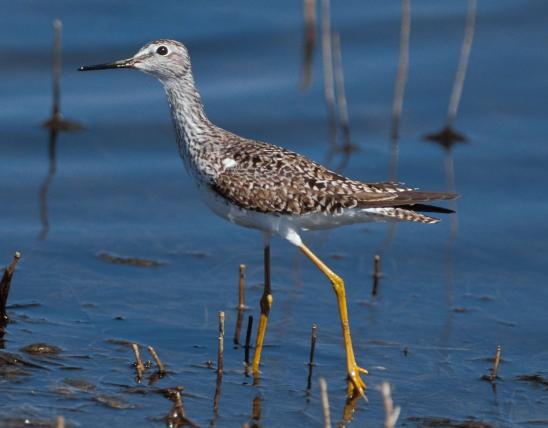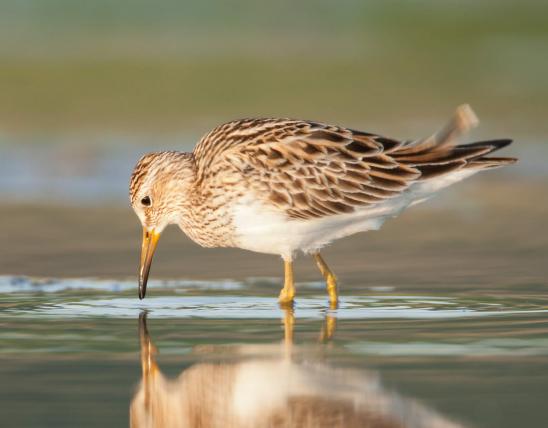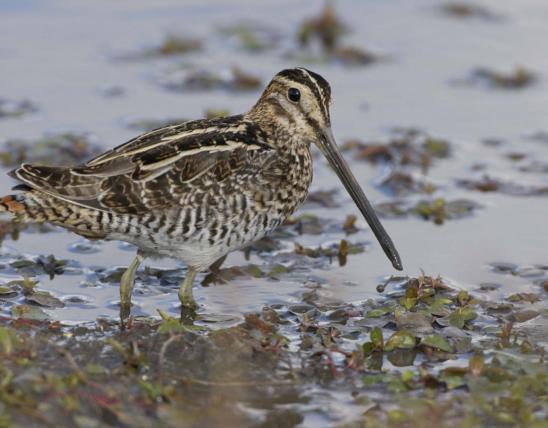
A large shorebird, the greater yellowlegs is black- and grayish-brown-streaked and -spotted above and on the breast; white below and on the rump. The bill is mostly black, slightly upturned, and more than 1½ times the length of the head, measured along the same line as the bill. Legs long, bright yellow. Call is a loud series of “tew, tew, tew” notes, usually 3 or more in a row. Calls can be confusing when birds are alarmed and taking off.
Similar species: Lesser yellowlegs has a straight, proportionately shorter bill (less than 1½ times the head length); its call is a soft “tu” or “tu tu.” It is also smaller overall, but that may not be apparent unless the two yellowlegs are seen side by side.
The greater yellowlegs is one of the more common of about 35 species of sandpipers and other shorebirds that migrate through Missouri in spring and fall. It takes effort to learn how to distinguish them. ID clues include plumage pattern, leg and bill color, silhouette (body shape and proportions), size, call, and foraging behavior.
Length: 14 inches (tip of bill to tip of tail).

Statewide.
Habitat and Conservation
Common migrant foraging on flooded pastures, flooded row-crop stubble, mudflats, shorelines, and marshes for worms and other invertebrates.
Food
The greater yellowlegs wades in shallow water, sweeping its bill side to side through the water. It eats worms and other invertebrates (both aquatic and terrestrial), plus other small animals, when they come in contact with the bill. This species sometimes actively chases its prey about. Foraging behavior is one of the clues for identifying the greater yellowlegs from other shorebirds.
Status
Common transient; accidental winter visitor.
Life Cycle
Greater yellowlegs pass north through the continental United States to breed in Canada and Alaska. They are ground nesters. As migrants, they appear in Missouri in late March through early May, peaking the second half of April. Returning south, they reappear in Missouri in late July through the end of October, peaking late August through early October. They spend winters along the southern coast of the United States and southward all the way to the southern tip of South America.
Human Connections
If alarmed, greater yellowlegs take flight but rarely go very far; they often circle back to the original location. Landing, they float momentarily on extended wings. This made them easy targets for gunners, in the days before conservation laws were enacted to save many shorebirds from extinction.
Ecosystem Connections
In mixed flocks of thousands of different kinds of shorebirds, the greater yellowlegs, with its piercing alarm call, is often the first to sound an alarm when danger threatens. Oldtimers called it “tattler” or “tell-tale” for this reason. Today, biologists study the dynamics of such communication between species.














About 350 species of birds are likely to be seen in Missouri, though nearly 400 have been recorded within our borders. Most people know a bird when they see one — it has feathers, wings, and a bill. Birds are warm-blooded, and most species can fly. Many migrate hundreds or thousands of miles. Birds lay hard-shelled eggs (often in a nest), and the parents care for the young. Many communicate with songs and calls.

























